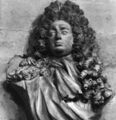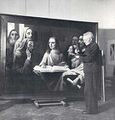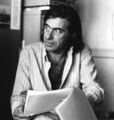Template:Selected anniversaries/October 10: Difference between revisions
No edit summary |
No edit summary |
||
| (7 intermediate revisions by the same user not shown) | |||
| Line 9: | Line 9: | ||
File:David Gregory.jpg|link=David Gregory (nonfiction)|1708: Mathematician and astronomer [[David Gregory (nonfiction)|David Gregory]] dies. At the Union of 1707, he was given the responsibility of reorganizing the Scottish Mint. | File:David Gregory.jpg|link=David Gregory (nonfiction)|1708: Mathematician and astronomer [[David Gregory (nonfiction)|David Gregory]] dies. At the Union of 1707, he was given the responsibility of reorganizing the Scottish Mint. | ||
File: | File:Henry Cavendish.jpg|link=Henry Cavendish (nonfiction)|1731: Chemist, physicist, and philosopher [[Henry Cavendish (nonfiction)|Henry Cavendish]] born. He will discover "inflammable air", later named hydrogen. | ||
||1770: Benjamin Wright born ... engineer who directed the construction of the Erie Canal. A one-time judge, he helped survey the Erie Canal route. When the Erie Canal was finally funded in 1817, Wright was selected as one of the three engineers to design and build it, then named chief engineer. Wright made the Erie Canal project a school of engineering. Until mid-century, almost every civil engineer in the U.S. had trained with, or been trained by someone who had worked under, Wright on the Erie Canal. Because he trained so many engineers on that project, Wright has been called the "father of American civil engineering." He also engaged in the design and construction at the outset of the first railroads. He was the first Chief Engineer of the Erie Railroad. Pic. | |||
||1837: Charles Fourier dies ... philosopher and academic. Pic. | ||1837: Charles Fourier dies ... philosopher and academic. Pic. | ||
||1846: Astronomer William Lassell discovers Triton, the largest moon of the planet Neptune. | ||1846: Astronomer William Lassell discovers Triton, the largest moon of the planet Neptune. Pic. | ||
||1861: Fridtjof Nansen born ... explorer, scientist, and humanitarian, Nobel Prize laureate ... Nansen Passport ... Pic. | ||1861: Fridtjof Nansen born ... explorer, scientist, and humanitarian, Nobel Prize laureate ... Nansen Passport ... Pic. | ||
File:Van meegeren trial.jpg|link=Han van Meegeren (nonfiction)|1889: Painter and forger [[Han van Meegeren (nonfiction)|Han van Meegeren]] born. He will be one of the most ingenious art forgers of the 20th century. | File:Van meegeren trial.jpg|link=Han van Meegeren (nonfiction)|1889: Painter and forger [[Han van Meegeren (nonfiction)|Han van Meegeren]] born. He will be one of the most ingenious art forgers of the 20th century. | ||
| Line 47: | Line 43: | ||
||1940: David Anthony Klarner born ... mathematician, author, and educator. He is known for his work in combinatorial enumeration, polyominoes, and box-packing. Pic: https://www.flickr.com/photos/thane/421802519 | ||1940: David Anthony Klarner born ... mathematician, author, and educator. He is known for his work in combinatorial enumeration, polyominoes, and box-packing. Pic: https://www.flickr.com/photos/thane/421802519 | ||
||1945: Joseph Darnand dies ... soldier in the French and later German militaries, a leader of the Vichy French collaborators with Nazi Germany and a Waffen-SS officer. Pic. | |||
||1945: Yuri Razuvaev born ... chess player and trainer. Pic (chess!). | ||1945: Yuri Razuvaev born ... chess player and trainer. Pic (chess!). | ||
| Line 53: | Line 49: | ||
||1949: Chikuhei Nakajima dies ... engineer, businessman, and politician, founded Nakajima Aircraft Company. Pic. | ||1949: Chikuhei Nakajima dies ... engineer, businessman, and politician, founded Nakajima Aircraft Company. Pic. | ||
||1957: Windscale fire nuclear accident: | File:Windscale nuclear power plant - Sept 1958.jpg|link=Windscale fire (nonfiction)|1957: [[Windscale fire (nonfiction)|Windscale fire nuclear accident]]: The fire burned for three days and there was a release of radioactive contamination that spread across the UK and Europe. The event was not an isolated incident; there had been a series of radioactive discharges from the piles in the years leading up to the accident. | ||
|File:Chrome Plover early publicity photo.jpg|link=Chrome Plover|1959: [[Chrome Plover]], the famous [[musical electroplating ensemble]], announces new tour. | |File:Chrome Plover early publicity photo.jpg|link=Chrome Plover|1959: [[Chrome Plover]], the famous [[musical electroplating ensemble]], announces new tour. | ||
| Line 73: | Line 69: | ||
||1979: Heinrich Adolph Louis Behnke dies ... mathematician. Pic. | ||1979: Heinrich Adolph Louis Behnke dies ... mathematician. Pic. | ||
||1979: Christopher | File:Christopher_Riche_Evans.jpg|link=Christopher Evans (nonfiction)|1979: Psychologist, computer scientist, and author [[Christopher Evans (nonfiction)|Christopher Evans]] dies. | ||
||1982: Jean Effel dies ... painter, caricaturist, illustrator and journalist. Pic search. | |||
||1986: Gleb Wataghin dies ... physicist and academic. Pic. | ||1986: Gleb Wataghin dies ... physicist and academic. Pic. | ||
| Line 81: | Line 79: | ||
||1997: Michael J. S. Dewar dies ... American theoretical chemist who developed the Dewar-Chatt-Duncanson model. Dewar is known most famously for the development in the 1970s and 1980s of the Semi-empirical quantum chemistry methods, MINDO, MNDO, AM1 and PM3 that are in the MOPAC computer program, and which for the first time enabled the quantitative study of the structure and mechanism of reaction (transition state) of many real (i.e. large) systems. Pic. | ||1997: Michael J. S. Dewar dies ... American theoretical chemist who developed the Dewar-Chatt-Duncanson model. Dewar is known most famously for the development in the 1970s and 1980s of the Semi-empirical quantum chemistry methods, MINDO, MNDO, AM1 and PM3 that are in the MOPAC computer program, and which for the first time enabled the quantitative study of the structure and mechanism of reaction (transition state) of many real (i.e. large) systems. Pic. | ||
||1998: Konstantin Petrzhak dies ... nuclear physicist and university professor of Polish origin. He discovered spontaneous fission of uranium with Georgy Flyorov in 1940; in addition, he also aided in Soviet Union's atomic bomb project. | ||1998: Konstantin Petrzhak dies ... nuclear physicist and university professor of Polish origin. He discovered spontaneous fission of uranium with Georgy Flyorov in 1940; in addition, he also aided in Soviet Union's atomic bomb project. Pic. | ||
||1998: William Markowitz dies ... astronomer, principally known for his work on the standardization of time. Pic: https://aas.org/obituaries/william-markowitz-1907-1998 | ||1998: William Markowitz dies ... astronomer, principally known for his work on the standardization of time. Pic: https://aas.org/obituaries/william-markowitz-1907-1998 | ||
| Line 90: | Line 88: | ||
||2015: Richard F. Heck dies ... chemist and academic, Nobel Prize laureate ... noted for the discovery and development of the Heck reaction, which uses palladium to catalyze organic chemical reactions that couple aryl halides with alkenes. Pic. | ||2015: Richard F. Heck dies ... chemist and academic, Nobel Prize laureate ... noted for the discovery and development of the Heck reaction, which uses palladium to catalyze organic chemical reactions that couple aryl halides with alkenes. Pic. | ||
</gallery> | </gallery> | ||
Latest revision as of 13:21, 7 February 2022
1641: Torricelli arrives in Arcetri to study with Galileo. ".. postpone his arrival at Arcetri until 10 October 1641. He took up residence in Galileo’s house, where Vincenzo Viviani was already living, and stayed there in close friendship with Galileo until the latter’s death on 8 January 1642.
1708: Mathematician and astronomer David Gregory dies. At the Union of 1707, he was given the responsibility of reorganizing the Scottish Mint.
1731: Chemist, physicist, and philosopher Henry Cavendish born. He will discover "inflammable air", later named hydrogen.
1889: Painter and forger Han van Meegeren born. He will be one of the most ingenious art forgers of the 20th century.
1957: Windscale fire nuclear accident: The fire burned for three days and there was a release of radioactive contamination that spread across the UK and Europe. The event was not an isolated incident; there had been a series of radioactive discharges from the piles in the years leading up to the accident.
1979: Psychologist, computer scientist, and author Christopher Evans dies.





